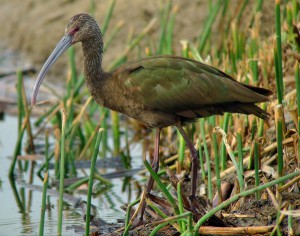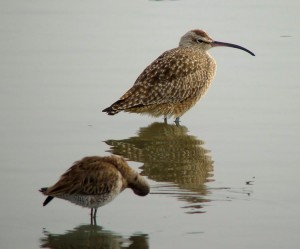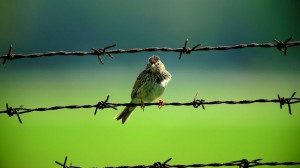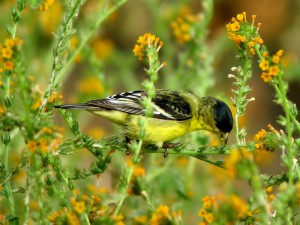We received a D-Lux 4 digital camera and several adapters from Leica to go along with the impressive Apo-Televid 82 scope (see scope review here) and have been happily field-testing it for several weeks now in preparation for a full review on the digiscoping outfit. This post is not a full review. Rather it gives people an idea of the capabilities of this adaptable and really easy-to-use outfit.
The rig consists of a D-Lux 4 digital camera, the digiscoping adapter and the Apo-Televid 82 scope and tripod. Given the weight of the scope, I opted for a full-sized carbon fiber tripod to counter-balance it. A carbon fiber tripod has the advantage of damping down vibrations. This is important when taking pictures, especially without a cable release. Unscrew the aluminum ring from the camera lens to reveal the adapter mounting threads. The adapter fits over the eyepiece (in this case, the 25-50x zoom eyepiece) and fixes in place with a set-screw. And that’s it! The whole operation takes about 30 seconds.
Photography
The first question most folks want to ask is: what kind of pictures can you take with this rig? Well, as it turns out, pretty good ones! For example, take a look at the detail in this basic-plumaged White-faced Ibis from San Joaquin Marsh Sanctuary. In winter, White-faced Ibis lack the white facial skin that gives them their name. Also, mottling appears on the head and upper neck. Note the pinkish tint to the tip of the long decurved bill, and the facial skin. The appearance of the back and wings suggests this bird undergoing pre-alternate molt. Highly iridescent green feathers replaced some of the dull older feathers on the head, belly and neck. While shooting, this bird got too close for photography, and to take these pictures I had to move back!
Image Richness
Another question is whether the image richness is sufficient to support really fine details of plumage and pattern. These resting shorebirds provided a good example proving it does. It also shows that the subtle plumage details stand out against a bright background.
Look at the feather detail in this Whimbrel. Note the pale buffy fringes of the wings and back and the warmer cinnamon tones of the breast. The rufous crown stripes stand out. The white eye ring pops, and the lower mandible is pink, while the legs are bluish gray. Even the rippling reflection below is rich with detail. The preening Long-billed Dowitcher is just a bit too far in front to be fully in focus. Still, some great feather details are visible in it too. Look at the dark-centered, pale-edged wing coverts to the dark chevrons on the sides of the belly. So, even in challenging light, surprising image detail is available.
Portability
How cumbersome and slow is the Leica D-Lux 4 digiscoping unit? Well, it’s really not. In fact, using this unit, I can often capture sharp images of small and rapidly moving birds. This group of Savannah Sparrows kept hopping up onto a barbed wire fence and alighting for a few seconds before spooking and dropping back down into the grass. But with a bit of luck and timing, the D-Lux 4 still caught this Vesper Sparrow, an uncommon bird in Orange County, among them. Note the characteristic white outer tail rectrices and black inner ones. The wind ruffled its head feathers, giving it a ‘punkish’ look, but the thin white eye ring is visible around the black eye. The depth of field is fairly good here too. We took this photo in 16:9 ratio mode, which yields a broader shot.
This feeding male Lesser Goldfinch provides another example. This bird was only about 25 feet away when I took these shots. But he kept hopping from plant to plant in search of more succulent bits to munch. You can see a piece of his meal clinging to the edge of his beak. Our west coast LEGOs have greenish backs with black streaking. Whereas those of the interior sometimes show completely black-backs. And of course, the Danish LEGOs come in many colors and can be used to build amazing things? The camera and scope picked up the subtle markings of the bird along with details in his claws along with the brilliant orange hues of the flowers and their green foliage.
Conclusions
So that should answer your questions. Digiscoping with the Leica D-Lux 4 camera and Apo-Televid 82 scope is incredibly easy. Additionally, it’s a lot of fun. If you don’t hear from me for a while, it’s because I stole this unit and went on the lam!




